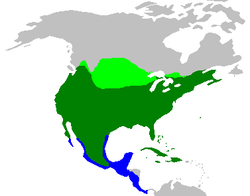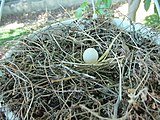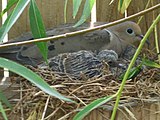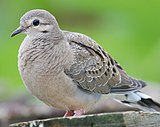|
Vikidia currently has 4,625 articles. Improve it! |
|
Join Vikidia: create your account now and improve it! |
Mourning dove
| Mourning Dove | |
|---|---|

| |
| Conservation status | |
| Scientific classification | |
| Kingdom: | Animalia |
| Phylum: | Chordata |
| Class: | Aves |
| Order: | Columbiformes |
| Family: | Columbidae |
| Genus: | Zenaida |
| Species: | Z. macroura |
| Binomial name | |
| Zenaida macroura (Linnaeus, 1758) | |

| |
| Template:Legend inlineTemplate:SpacesTemplate:Legend inlineTemplate:SpacesTemplate:Legend inline | |
The Mourning Dove (scientific name : Zenaida macroura) is a member of the dove family (Columbidae).[Note 1] It has five subspecies. The number of Mourning Doves is estimated to be approximately 475 million. They are found in North America. Mourning Doves are light grey and brown, and males and females look similar.
The species mostly have one partner at a time. Both parents incubate and care for their chicks. Adult Mourning Doves usually eat only seeds. The young are fed crop milk by the parents.
The Mourning Dove is hunted both for sport and meat. Up to 70 million birds are shot in the United States every year. Its mournful woo-oo-oo-oo call gives the bird its name. The bird is a strong flier, and can fly at up to 88 km/h.[2]
Distribution[edit | edit source]
The Mourning Dove has a large range of nearly 11 million square kilometers (6.8 million square miles).[3] It is found throughout the Greater Antilles, most of Mexico, the Continental United States, and southern Canada. In the summer, the birds are mostly seen in the Canadian prairies, and in southern Central America in the winter.[4] The species is a vagrant in northern Canada, Alaska,[5] and South America. It has been seen at least seven times in the Palearctic ecozone with records from the British Isles (five), the Azores (one) and Iceland (one).[6] In 1963, the Mourning Dove was introduced to Hawaii, and in 1998 there was still a small population in North Kona, Hawaii.[7]
The Mourning Dove lives in a wide variety of habitats, such as farms, prairie, grassland, and woods. It does not live in swamps or thick forests.[5] The species have also live in places where humans are, such as in cities or near farmsteads.[8]
Description[edit | edit source]

The Mourning Dove is a medium-sized, slender dove. It weighs an average of Template:Convert/toTemplate:Convert/test/A.[9] It has a small head and a long tail. Mourning Doves have perching feet, with three toes facing forward and one facing backward. The legs are short and have a reddish color. The beak is small and dark, usually a mixture of brown and black.[6]
Its feathers are generally light gray-brown and lighter and more pink below. The wings may have black spots, and the outer tail feathers are white. The eyes are dark, with light skin around them.[6] The adult male has bright purple-pink patches on the sides of its neck, with light pink coloring up to the breast. Younger birds look more scaly and dark.[6]
All five subspecies of the Mourning Dove look similar and cannot be told apart easily.[6] The Western subspecies has longer wings, a longer beak, shorter toes, and is more lighter in color. The Panama Mourning Dove has shorter wings and legs, a longer beak, and is grayer in color. The Clarion Island subspecies has larger feet, a larger beak, and is darker brown in color.[4]
Sounds[edit | edit source]
This species' call is a cooOOoo-woo-woo-woooo, which is used by males when attracting a mate. Other sounds include a nest call (cooOOoo) by paired males to attract their mates to the nests, a greeting call (a soft ork) by males upon joining their mates again, and an alarm call (a short roo-oo) by either male or female when in danger. In flight, the wings make a fluttery whistling sound that is quiet and hard to hear, but is louder at take-off and landing.[6]
Reproduction[edit | edit source]
The male begins courtship by flying noisily, and then in a graceful, circular glide with its wings outstretched and head down. After landing, the male will go to the female with a puffed out breast, bobbing head, and loud calls. Once the pair is mated, they will often spend time preening each other’s feathers.[5] The Mourning Dove does not easily leave its mate.[4] Pairs may sometimes remain together throughout the winter. However, lone doves will find new partners if necessary.[10]
After mating, the male shows the female all the potential nest sites, and lets the female choose one and build the nest. The male will fly about, gather material, and bring it to her. The male stands on the female's back to give the material to the female, who builds it into the nest.[11] The nest is constructed of twigs, conifer needles, or grass.[4] Sometimes, Mourning Doves will take place of the unused nests of other Mourning doves, birds, or mammals such as squirrels.[4]
Most nests are in trees, but they can also be found in shrubs, vines, or on buildings and hanging flower pots.[11] When there is no suitable place to nest above, Mourning Doves will nest on the ground.[4] The nest is almost always big enough for exactly two eggs.[11] Sometimes, however, a female will lay her eggs in the nest of another pair, leading to three or four eggs in the nest.[4] The eggs are small and white.
Both sexes incubate; the male from morning to afternoon, and the female the rest of the day and at night. Mourning Doves rarely leave their nest alone.[11] Incubation takes two weeks.
Both parents feed the squabs crop milk for the first 3–4 days of life.[4][12][13] After that, they gradually begin to eat seeds. The feathers and wing muscles begin to develop for flight in about 11–15 days. This happens before the squabs are fully grown, but after they digest the adult food. They stay nearby to be fed by their father for up to two weeks after fledging.[5]
Mourning Doves breed quickly. In warmer areas, these birds may raise up to six broods in a season.[5] This fast breeding is essential because they cannot live long. Each year, the mortality can reach 58% a year for adults and 69% for the young.[4]
Ecology[edit | edit source]

Mourning Doves eat almost only seeds, which make up more than 99% of their diet.[14] Rarely, they will eat snails or insects. Mourning Doves generally eat enough to fill their stomach and then fly away to digest while resting. They often swallow gravel or sand to help them digest. At bird feeders, Mourning Doves are attracted to corn, millet, and sunflower seeds. Mourning Doves do not dig or scratch for seeds, but only eat what they can see.[4] They will sometimes perch on plants and eat from them.[5]
Mourning Doves especially prefer pine nuts, sesame, and wheat.[4] When their favorite foods are absent, Mourning Doves will eat the seeds of other plants, including buckwheat and rye.[4]
Mourning Doves can be easily harmed with several different parasites and diseases, including tapeworms, nematodes, mites, and lice. The Trichomonas gallinae, a parasite which lives in the mouth, is especially severe. While the bird sometimes shows no ill effects, the parasite often causes a yellowish growth in the mouth and throat. This can cause the bird to starve to death.[4]
The greatest predators of this species are birds of prey, such as falcons and hawks. Other times, during nesting, corvids, grackles, house cats or rat snakes will prey on their eggs.[4] Cowbirds rarely parasitize Mourning Dove nests. Mourning Doves reject slightly under a third of Cowbird eggs in such nests, and the Cowbirds cannot eat the Mourning Dove's vegetarian diet.[15]
Behavior[edit | edit source]
Like other columbids, the Mourning Dove drinks without lifting or tilting its head. They often gather at drinking spots around dawn and dusk.
Mourning doves wash themselves in the sun or rain. These birds can also take baths in shallow pools or bird baths. They may sometimes bathe themselves in the dust as well.
The bird is a strong flier, and can fly up to the speed of 88 km/h.[2]
When they are not breeding, Mourning Doves roost in dense deciduous trees or in conifers. During sleep, the head rests between the shoulders, close to the body, and is not tucked under the shoulder feathers as most species do. Sometimes, roosting is delayed on colder days during the winter in Canada.[16]
Conservation status[edit | edit source]
The number of individual Mourning Doves is estimated to be approximately 475 million.[17] The large population and its vast range explains why the Mourning Dove is considered to be of least concern, which means that the species is not at immediate risk.[3] Around 40–70 million birds are shot as game every year.[18]
Taxonomy[edit | edit source]
The Mourning Dove is closely related to the Eared Dove (Zenaida auriculata) and the Socorro Dove (Zenaida graysoni). Sometimes these three birds are put in the separate genus Zenaidura.[19] The Socorro Dove was once thought to be the same species as the Mourning Dove. However, differences in behavior, call, and appearance separate them as two different species.[20]
There are five subspecies of Mourning Dove:
- Eastern Z. m. carolinensis (Linnaeus, 1766)
- Clarion Island Z. m. clarionensis (C.H.Townsend, 1890)
- West Indian Z. m. macroura (Linnaeus, 1758)
- Western Z. m. marginella (Woodhouse, 1852)
- Panama Z. m. turturilla (Wetmore, 1956)
The West Indian subspecies is found throughout the Greater Antilles.[4] It is also found in the Florida Keys.[6] The Eastern subspecies lives mainly in eastern North America, as well as Bermuda and the Bahamas. The Western subspecies is found in western North America and parts of Mexico. The Panamanian subspecies is located in Central America. The Clarion Island subspecies is found just off the Pacific coast of Mexico.[4]
The Mourning Dove is sometimes called the American Mourning Dove, because it may be confused with the distantly related African Mourning Dove (Streptopelia decipiens). It also used to be known as the Carolina Turtledove or Carolina Pigeon.[21] The species' scientific name was given in 1838 by French zoologist Charles L. Bonaparte, honoring his wife, Princess Zénaide.[22] The "mourning" part of its name comes from its call.[23]
Closest relative[edit | edit source]
The Mourning Dove is thought to be most closely related to the extinct Passenger Pigeon (Ectopistes migratorius).[24][25][26]
As a symbol and in the arts[edit | edit source]
The Eastern Mourning Dove (Z. m. carolinensis) is Wisconsin's official symbol of peace.[27] The bird is also Michigan's state bird of peace.[28]
The Mourning Dove appears as the Carolina Turtle-Dove on plate 286 of Audubon's The Birds of America.[21]
Mourning Doves are referred to often in American literature, and they can also be found in some American and Canadian poetry such as in the works of Robert Bly, Jared Carter,[29] Lorine Niedecker,[30] and Charles Wright.[31]
References[edit | edit source]
- ↑ "IUCN Red List of Threatened Species on Zenaida macroura (American Mourning Dove, Mourning Dove)". The IUNC Red List of Threatened Species. International Union for Conservation of Nature and Natural Resources. 2012. http://www.iucnredlist.org/apps/redlist/details/106002554/0. Retrieved 29 May 2012.
- ↑ 2.0 2.1 Bastin, E.W., 1952, Flight-speed of the mourning dove, Wilson Bulletin 64: 47.
- ↑ 3.0 3.1 Birdlife International. "Mourning Dove - BirdLife Species Factsheet". http://www.birdlife.org/datazone/species/index.html?action=SpcHTMDetails.asp&sid=2554&m=0. Retrieved 30 January 2012.
- ↑ 4.00 4.01 4.02 4.03 4.04 4.05 4.06 4.07 4.08 4.09 4.10 4.11 4.12 4.13 4.14 4.15 "Mourning Dove (Zenaida macroura)" (PDF). Fish and Wildlife Habitat Management leaflet 31. National Resources Conservation Services (NRCS). February 2006. p. 2. http://www.sc.nrcs.usda.gov/intranet/Dick%20Yetter%20Information/Tech%20Notes%20for%20Web%20Site/Biology%20Tech%20Note_31_MourningDove.pdf. Retrieved 30 January 2012.
- ↑ 5.0 5.1 5.2 5.3 5.4 5.5 Kaufman, Kenn (1996). Lives of North American Birds. Houghton Mifflin. p. 293. ISBN 0-395-77017-3.
- ↑ 6.0 6.1 6.2 6.3 6.4 6.5 6.6 Alderfer, Jonathan K. National Geographic Complete Birds of North America. National Geographic. p. 303. ISBN 0792241754.
- ↑ "Check-list of North American Birds" (PDF). American Ornithologists' Union. 1998. p. 224. http://www.aou.org/checklist/pdf/AOUchecklistPter-Apod.pdf. Retrieved 30 January 2012.
- ↑ "Mourning Dove". Bird Web.org. Seattle Audubon Society. 2012. http://www.birdweb.org/birdweb/bird/mourning_dove. Retrieved 30 May 2012.
- ↑ Miller, Wilmer J. (16 January 1969). "The biology and natural history of the Mourning Dove". http://www.ringneckdove.com/Wilmer's%20WebPage/mourning__doves.htm. Retrieved 30 January 2012. "Mourning doves weigh 4–6 ounces, usually close to the lesser weight."
- ↑ Mauldin, Margaret (2012). "Dove Hunting :: Mourning Doves widely hunted in United States". Dove Society.org. http://www.dovesociety.org/mourning_doves_widely_hunted_in_the_united_states.cfm. Retrieved 30 May 2012.
- ↑ 11.0 11.1 11.2 11.3 "Mourning Dove". Cornell Lab of Ornithology. http://www.birds.cornell.edu/AllAboutBirds/BirdGuide/Mourning_Dove_dtl.html. Retrieved 30 January 2012.
- ↑ Ehrlich, Paul R. et al (1988) "Bird Milk". Stanford University.
- ↑ Silver, Rae (1984). "Prolactin and parenting in the pigeon family". The Journal of Experimental Zoology 232: 617–625. http://www.columbiauniversity.org/cu/psychology/silver/publications/035Silver%201984.PDF.
- ↑ Cornell Lab of Ornithology (2011). "Mourning Dove, Life History". All About Birds. Cornell University. http://www.allaboutbirds.org/guide/Mourning_dove/lifehistory/ac. Retrieved 30 January 2012.
- ↑ Brian Peer; Eric Bollinger (October 1998). "Rejection of Cowbird eggs by Mourning Doves: A manifestation of nest usurpation?" (PDF). The Auk. http://elibrary.unm.edu/sora/Auk/v115n04/p1057-p1062.pdf. Retrieved 30 January 2012.
- ↑ Doucette D.R., and Reebs S.G. 1994. Influence of temperature and other factors on the daily roosting times of Mourning Doves in winter. Canadian Journal of Zoology 72: 1287-1290.
- ↑ Mirarchi R.E., and Baskett T.S. 1994. Mourning Dove (Zenaida macroura). In A. Poole and F. Gill, eds. The Birds of North America, #117. Philadelphia: The Academy of Natural Sciences; Washington, DC: The American Ornithologists' Union.
- ↑ Sadler, K.C. (1993). Mourning Dove harvest. Harrisburg, PA: Stackpole Books.
- ↑ "Eared Dove (Zenaida auriculata) | the Internet Bird Collection". The Internet Bird Collection. 2012. http://ibc.lynxeds.com/species/eared-dove-zenaida-auriculata. Retrieved 29 May 2012.
- ↑ "Check-list of North American Birds" (PDF). American Ornithologists' Union. 1998. p. 225. http://www.aou.org/checklist/pdf/AOUchecklistPter-Apod.pdf. Retrieved 30 January 2012.
- ↑ 21.0 21.1 Audubon, John James. "Plate CCLXXXVVI". Birds of America. ISBN 1-55859-128-1. http://www.abirdshome.com/Audubon/VolV/00506.html. Retrieved 30 January 2012.
- ↑ Wells, Diana (2002). "100 Birds and How They Got Their Names". Algonquin Books of Chapel Hill. ISBN 156512281X.
- ↑ "Mourning Dove (Zenaida macroura) - Birds of Quinta Mazatlan". Quintamazatlan. 2012. http://www.quintamazatlan.com/birds/explore/birdsofquinta/mourning_dove.aspx. Retrieved 2 June 2012.
- ↑ "Encyclopedia Smithsonian: The Passenger Pigeon". Encyclopedia Smithsonian. 2012. http://www.si.edu/Encyclopedia_si/nmnh/passpig.htm. Retrieved 2 June 2012.
- ↑ "Biography of Mourning Dove". ringneckdove.com. 2006. http://www.ringneckdove.com/Wilmer%27s%20WebPage/mourning__doves.htm. Retrieved 2 February 2012.
- ↑ "Dove History | MDC". MDC online. Missouri Department of Conservation. 2012. http://mdc.mo.gov/discover-nature/outdoor-recreation/nature-viewing/birding/mourning-doves-missouri/dove-history. Retrieved 2 February 2012.
- ↑ Government of Wisconsin. "State Symbols". http://www.wisconsin.gov/state/core/wisconsin_state_symbols.html. Retrieved 30 January 2012.
- ↑ Audi, Tamara (16 October 2006). "Dove hunting finds place on Mich. ballot". USA Today. http://www.usatoday.com/news/nation/2006-10-16-dove-hunting_x.htm. Retrieved 30 January 2012.
- ↑ Carter, Jared (2012). "Poems: 'Mourning Doves'". Jared Carter Poetry. http://www.jaredcarter.com/poems/6/. Retrieved 2 February 2012.
- ↑ "Lorine Niedecker Poetry Selections". Friends of Lorine Niedecker, Inc. 2012. Archived from the original on 18 October 2010. http://web.archive.org/web/20101018031836/http://www.lorineniedecker.org/poems.html. Retrieved 2 February 2012.
- ↑ Wright, Charles. "Meditation on song and structure from Negative Blue: selected later poems". http://archive.salon.com/books/feature/2000/04/14/national_poetry_month/print.html. Retrieved 4 June 2012.
Notes[edit | edit source]
- ↑ The bird is also called the Western Turtle Dove or American Mourning Dove or Rain Dove, and used to be known as the Carolina Pigeon or Carolina Turtledove.
Other websites[edit | edit source]
- "More detailed information about breeding/nesting habits". Archived from the original on 27 September 2007. http://web.archive.org/web/20070927061759/http://www.dlia.org/atbi/species/Animalia/Chordata/Aves/Columbiformes/Columbidae/Zenaida_macroura.shtml.
- Mourning Doves on the Internet Bird Collection
- USGS page
- Information from Cornell Lab of Ornithology
- South Dakota Birds page
- Mourning Dove Movies (Tree of Life)
- 28 Mourning Dove Photos
- Video of a Mourning Dove's Call
- Mourning Dove Bird Sound

|
Animals Portal — All articles about animals |








